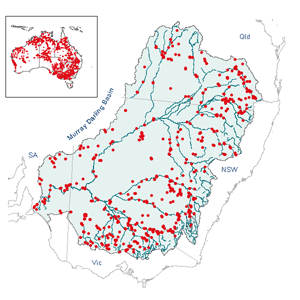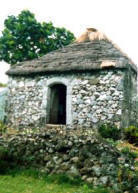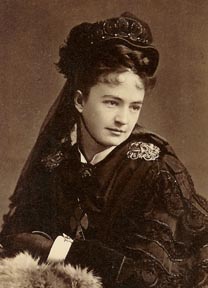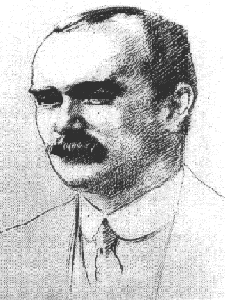About 700; see the
List of Eucalyptus species Eucalyptus (From Greek, ευκάλυπτος = "Well covered") is a diverse
genus of
trees (and a few shrubs), the members of which dominate the tree flora of
Australia. There are more than seven hundred species of
Eucalyptus, mostly native to Australia, with a very small number found in adjacent parts of
New Guinea and
Indonesia and one as far north as the
Philippine islands.
Members of the genus can be found in almost every region of the Australian continent, because they have adapted to all of its climatic conditions; in fact no other continent is so characterised by a single genus of tree as Australia is by its eucalyptus. Many, but far from all, are known as
gum trees in reference to the habit of many species to exude copious sap from any break in the bark (e.g.
Scribbly Gum).
Description A
Eucalyptus may be mature as a low shrub or as a very large tree. There are three main habit and four size categories that
species can be divided into.
As a generalisation "
forest trees" are single-stemmed and have a
crown forming a minor proportion of the whole tree height. "
Woodland trees" are single-stemmed although they may branch at a short distance above ground level.
"
Mallees" are multi-stemmed from ground level, usually less than 10 metres in height, often with the crown predominantly at the ends of the branchlets and individual plants may combine to form either an open or closed formation. Many mallee trees may be so low growing as to be considered a
shrub.
Apart from the forest tree, woodland tree, mallee and shrub habits two further tree forms are notable in
Western Australia. One of these is the "
mallet", which is a small to medium-sized tree, usually of steep branching habit, sometimes fluted at the base of the trunk and often with a conspicuously dense,
terminal crown. It is the habit usually of mature healthy specimens of
Eucalyptus occidentalis,
E. astringens,
E. spathulata,
E. gardneri,
E. dielsii,
E. forrestiana,
E. salubris,
E. clivicola and
E. ornata. The smooth
bark of mallets often has a satiny sheen and may be white, cream, grey, green or copper.
Another habit category used in Western Australia is the "
marlock". This has been variously applied but Brooker & Hopper (2001) defined the term and restricted the use to describe the more or less pure stands of short, erect, thin-stemmed "trees" that do not produce
lignotubers. These are easily seen and recognised in stands of
E. platypus,
E. vesiculosa and the unrealted
E. stoatei. The marlock is distinguished from mallets which are taller and have a characteristic steep branching habit. The origin and use of the term "morrel" is somewhat obscure and appears to apply to trees of the western Australian wheatbelt and
goldfields which have a long, straight trunk, completely rough barked. It is now used mainly for
E. longicornis (Red Morell) and
E. melanoxylon (Black Morrel).
Tree sizes follow the
convention of:
- Small - to 10 metres in height
- Medium sized - 10 to 30 metres in height
- Tall - 30 to 60 metres in height
- Very Tall - over 60 metres in height
Small - to 10 metres in height
Medium sized - 10 to 30 metres in height
Tall - 30 to 60 metres in height
Very Tall - over 60 metres in height
Size and habit Nearly all
Eucalyptus are
evergreen but some tropical species lose their leaves at the end of the dry season. As in other members of the
Myrtle family,
Eucalyptus leaves are covered with oil glands. The copious oils produced are an important feature of the genus.
The leaves on a mature
Eucalyptus plant are commonly
lanceolate,
petiolate, apparently
alternate and waxy or glossy green. In contrast the leaves of seedlings are frequently
opposite,
sessile and
glaucous. However there are numerous exceptions to this pattern. Many species such as
E. melanophloia and
E. setosa retain the juvenile leaf form even when the plant is reproductively mature. Some species such as
E. macrocarpa,
E. rhodantha and
E. crucis are sought after ornamentals due to this lifelong juvenile leaf form. A few species such as
E. petraea,
E. dundasii and
E. lansdowneana have shiny green leaves throughout their life cycle.
E. caesia exhibits the opposite pattern of leaf development to most
Eucalyptus, with shiny green leaves in the seedling stage and dull, glaucous leaves in mature crowns. The contrast between juvenile and adult leaf phases is valuable in field identification.
Four leaf phases are recognised in the development of a
Eucalyptus plant - the 'seedling', 'juvenile', 'intermediate' and 'adult' phases. However there is no definite transitional point between the phases. The intermediate phase, when the largest leaves are often formed, links the juvenile and adult phases. Most species do not flower until adult foliage starts to appear;
E. cinerea and
E. perriniana are notable exceptions.
In all except a few species the leaves form in pairs on opposite sides of a square stem, consecutive pairs being at right angles to each other (decussate). In some narrow-leaved species - for example
E. oleosa - the seedling leaves after the second leaf pair are often clustered in a detectable spiral arrangement about a five sided stem. After the spiral phase, which may last from several to many nodes, the arrangement reverts to decussate by the absorption of some of the leaf bearing faces of the stem. In those species with opposite adult foliage the leaf pairs, which have been formed opposite at the stem apex, become separated at their bases by unequal elongation of the stem to produce the apparently alternate adult leaves.
Leaves The most readily recognisable characteristics of Eucalyptus species are its distinctive flowers and fruit (capsule). Flowers have numerous fluffy stamens which may be white, cream, yellow, pink or red; in bud the stamens are enclosed in a cap known as an operculum which is composed of the fused sepals or petals or both. Thus flowers have no petals, decorating themselves instead with the many showy stamens. As the stamens expand the operculum is forced off, splitting away from the cup-like base of the flower; this is one of the features that that unites the genus. The name Eucalyptus, from the Greek words
eu-, well, and
kaluptos, cover, meaning "well-covered", describes the operculum. The woody fruits or capsules, known as gumnuts, are roughly cone-shaped and have valves at the end which open to release the seeds. Most species do not flower until adult foliage starts to appear;
Eucalyptus cinerea and
Eucalyptus perriniana are notable exceptions.
Flowers The appearance of
Eucalyptus bark will vary with the age of the plant, the manner of bark shed, the length of the bark fibres, the degree of furrowing, the thickness, the hardness and the colour. All mature eucalypts put on an annual layer of bark, which contributes to the increasing diameter of the stems. In some species the outermost layer dies and is annually deciduous either in long strips (as in
Eucalyptus sheathiana) or in variably sized flakes (
Eucalyptus diversicolor,
Eucalyptus cosmophylla or
Eucalyptus cladocalyx). These are the gums or smooth-barked species. The gum bark may be dull, shiny or satiny (as in
Eucalyptus ornata) or matt (
Eucalyptus cosmophylla). In many species the dead bark is retained. Its outermost layer gradually fragments with weathering and sheds without altering the essentially rough barked nature of the trunks or stems - for example
Eucalyptus marginata,
Eucalyptus jacksonii,
Eucalyptus obliqua and
Eucalyptus porosa.
Many species are 'half-barks' or 'blackbutts' in which the dead bark is retained in the lower half of the trunks or stems - for example,
Eucalyptus brachycalyx,
Eucalyptus ochrophloia and
Eucalyptus occidentalis - or only in a thick, black accumulation at the base, as in
Eucalyptus clelandii. Some species in this category - for example -
Eucalyptus youngiana - the rough basal bark is very ribbony at the top, where it gives way to the smooth upper stems. The smooth upper bark of the half barks and that of the completely smooth-barked trees and mallees can produce remarkable colour and interest, for example
Eucalyptus deglupta.
Bark Stringybark - consists of long-fibres and can be pulled off in long pieces. It is usually thick with a spongy texture.
Ironbark - is hard, rough and deeply furrowed. It is impregnated with dried kino (a
sap exuded by the tree) which gives a dark red or even black colour.
Tessellated - bark is broken up into many distinct flakes. They are
corkish and can flake off.
Box - has short fibres. Some also show tessellation.
Ribbon - this has the bark coming off in long thin pieces but still loosely attached in some places. They can be long ribbons, firmer strips or twisted curls.
Bark characteristics There are over 700
species of Eucalyptus; refer to the
List of Eucalyptus species for a comprehensive list of species. It is believed that all eucalypts are related either closely or remotely. Some have
diverged from the mainstream of the
genus to the extent that they are quite isolated
genetically and are able to be recognised by only a few relatively
invariant characteristics. Most, however, may be regarded as belonging to large or small groups of related species, which are often in
geographical contact with each other and between which
gene exchange still occurs. In these situations many species will appear to grade into one another and intermediate forms are common. In other words, some species are relatively fixed genetically, as expressed in their
morphology, while others have not diverged completely from their nearest relatives.
Hybrid individuals have not always been recognised as such on first collection and some have been named as new species, such as
E. chrysantha (
E. preissiana ×
E. sepulcralis) and
E. "rivalis" (
E. marginata ×
E. megacarpa). Hybrid combinations are not particularly common in the field, but some other published species have been suggested to be hybrid combinations and are frequently seen in Australia. For example,
E. erythrandra is believed to be
E. angulosa ×
E. teraptera and due to its wide distribution is often referred to in texts.
Species and hybridism A small genus of similar trees,
Angophora, has also been known since the
18th century. In
1995 new evidence, largely genetic, indicated that some prominent
Eucalyptus species were actually more closely related to
Angophora than to the other eucalypts; they were split off into the new
genus Corymbia. Although separate, the three groups are allied and it remains acceptable to refer to the members of all three genera
Angophora,
Corymbia and
Eucalyptus as "eucalypts". The coolibah trees, referred to in
Waltzing Matilda, are
Eucalyptus E. coolabah and
E. microtheca.
 Related genera
Related genera Today, specimens of the Australian Mountain Ash,
Eucalyptus regnans, are among the tallest trees in the world at up to 92 metres in height and the tallest of all flowering plants (
Angiosperms); taller trees such as the
Coast Redwood are all
conifers (
Gymnosperms). There is credible evidence however that at the time of European settlement of Australia some Mountain Ash were indeed the tallest plants in the world.
Tall timber Most eucalypts are not tolerant of frost, or only tolerate light frosts down to -3°C to -5°C; the hardiest, are the so-called Snow Gums such as
Eucalyptus pauciflora which is capable of withstanding cold and frost down to about -20°C. Two sub-species,
E. pauciflora subsp. niphophila and
E. pauciflora subsp. debeuzevillei in particular are even hardier and can tolerate even quite severe
winters. Several other species, especially from the high plateau and mountains of central
Tasmania such as
Eucalyptus coccifera,
Eucalyptus subcrenulata, and
Eucalyptus gunnii, have produced extreme cold hardy forms and it is seed procured from these
genetically hardy strains that are planted for ornament in colder parts of the world.
Tolerance An
essential oil extracted from eucalyptus leaves contains compounds that are powerful natural disinfectants and which can be toxic in large quantities. Several
marsupial herbivores, notably
koalas and some
possums, are relatively tolerant of it. The close correlation of these oils with other more potent toxins called formylated
phloroglucinol compounds allows koalas and other
marsupial species to make food choices based on the smell of the leaves. However, it is the formylated phloroglucinol compounds that are the most important factor in choice of leaves by koalas. Eucalyptus flowers produce a great abundance of
nectar, providing food for many
pollinators including
insects, birds,
bats and
possums. Despite the fact that eucalyptus trees are well-defended from herbivores by their toxic essential oils they do have their share of insect pests, such as the Eucalyptus
Longhorn Borer Beetle,
Phoracantha semipunctuata, or the aphid-like
psyllids known as "
bell lerps," both of which have become established as pests throughout the world wherever eucalypts are cultivated.
Further information: list of Lepidoptera which feed on Eucalyptus Animal relationships Some species of Eucalyptus have a habit of dropping entire branches off as they grow. Eucalyptus forests are littered with dead branches. The Australian Ghost Gum
Eucalyptus papuana is also termed the "widow maker," due to the high number of pioneer tree-felling workers who were killed by falling branches. Many people have been killed as they camped underneath the trees. It is thought the trees shed very large branches to conserve water during periods of drought. This may be the real reason behind the
drop bear story told to children - the idea is to keep them away from being under dangerous branches.
Hazards On warm days vapourised eucalyptus oil rises above the
bush to create the characteristic distant blue haze of the Australian landscape. Eucalyptus oil is highly flammable (trees have been known to explode
The two valuable timber trees, Alpine Ash
E. delegatensis and Mountain Ash
E. regnans, are killed by fire and only regenerate from seed. The same 2003 bushfire that had little impact on forests around
Canberra resulted in thousands of hectares of dead ash forests. However, a small amount of ash survived and put out new suckers as well. There has been some debate as to whether to leave the stands, or attempt to harvest the mostly undamaged timber, which is increasingly recognised as a damaging practice.
Fire - Eucalyptus have many uses which have made them
economically important trees. Perhaps the
Karri and the
Yellow box varieties are the best known. Due to their fast growth the foremost benefit of these trees is the wood. They provide many desirable characteristics for use as ornament, timber, firewood and
pulpwood. Fast growth also makes eucalypts suitable as
windbreaks. Eucalypts draw a tremendous amount of water from the soil through the process of
transpiration. They have been planted (or re-planted) in some places to lower the water table and reduce
soil salination. Eucalypts have also been used as a way of reducing
malaria by draining the soil in Algeria, Sicily.
Cultivation and uses Although Eucalypts must have been seen by the very early European explorers and collectors, no botanical collections of them are known to have been made until
1770 when
Joseph Banks and
Daniel Solander arrived at
Botany Bay with
Captain James Cook. There they collected specimens of
E. gummifera and later, near the
Endeavour River in northern
Queensland, they collected
E. platyphylla; neither of these species was named as such at the time.
In
1777, on Cook's third expedition, David Nelson collected a eucalypt on
Bruny Island in southern
Tasmania. This specimen was taken to the
British Museum in
London, and it was named
Eucalyptus obliqua by the French botanist
L'Héritier, who was working in London at the time. He coined the generic name from the Greek roots
eu and
calyptos, meaning "well" and "covered" in reference to the
operculum of the flower bud. This organ protects the developing flower parts as the flower develops and is shed by the pressure of the emerging
stamens at flowering.
The name
obliqua was derived from the Latin
obliquus, meaning "oblique" which is the
botanical term describing a
leaf base where the two sides of the leaf blade are of unequal length and do not meet the petiole at the same place.
In naming
E. obliqua,
L'Héritier caused to be perpetuated, most likely by accident, a feature common to all eucalypts - the operculum. In his choice of a specific name, he recognised not only the characteristic feature of
E. obliqua, but one common to many other species as well.
E. obliqua was published in
1788-89 and coincides with the date of the first official European settlement of Australia.
Between 1788-89 and the turn of the nineteenth century several more species of
Eucalyptus were named and published. Most of these were by the English botanist
James Edward Smith and most were, as might be expected, trees of the
Sydney region. These include the economically valuable
E. pilularis,
E. saligna and
E. tereticornis.
The nineteenth century saw the endeavours of several of the great botanists in Australian history, particularly
Ferdinand von Mueller, whose work on eucalypts contributed greatly to the first comprehensive account of the genus in
George Bentham's
Flora Australiensis in 1867 - which today remains the only complete Australian flora. The account in Bentham is the most important early systematic treatment of the genus. Bentham divided the genus into five series whose distinctions were based on characteristics of the stamens, particularly the anthers (Mueller, 1879-84), elborated further by Joseph Henry Maiden (1903-33), and taken even further by William Faris Blakely (1934). By this time the anther system had become too complex to be workable and more recent systematic work has concentrated on the characteristics of buds, fruits, leaves and bark.
The first endemic Western Australian
Eucalyptus to be collected and subsequently named was the yate (
E. cornuta) by the French botanist
La Billardiére, who collected in what is now the
Esperance area in
1792.
History Eucalyptus was first introduced to the rest of the world by
Sir Joseph Banks,
botanist, on the
Cook expedition in 1770. They have subsequently been introduced to many parts of the world, notably
California,
Brazil,
Ecuador,
Colombia,
Ethiopia,
Morocco,
Portugal,
South Africa,
Israel,
Galicia and
Chile. In
Spain they have been planted in pulpwood
plantations, replacing native
oak woodland.
Eucalyptus are the basis for several industries, such as sawmilling, pulp, charcoal and others. Several species have become
invasive and are causing major problems for local ecosystems.
California In 1910
Eucalyptus was introduced to Brazil for
timber substitution and the
vegetal coal industry. It has adpated very well to the local environmental conditions and today there are around 5 million hectares planted. The wood produced by the tree is highly appreciated by the charcoal and pulp and paper industries. The short rotation allows a larger wood production and supply wood for several other activities, helping to preserve the native forests from logging. When well managed the plantations are sustainable and the soil can sustain endless replantations. Eucalyptus plantations are also used as
wind breaks.
Brazil This species was introduced to
Ethiopia in either 1894 or 1895, either by Emperor
Menelik II's French advisor Mondon-Vidailhet or the Englishman Captain O'Brian. Due to massive deforestation around his new capital city
Addis Ababa caused by a growing appetite for
fire wood, Emperor
Menelik II endorsed its planting around that city; according to
Richard R.K. Pankhurst, "The great advantage of the eucalypts was that they were fast growing, required little attention and when cut down grew up again from the roots; it could be harvested every ten years. The tree proved successful from the onset". The eucalypt remains a defining feature of Addis Ababa.
Photo gallery

 History
History

 Municipalities
Municipalities Later military events
Later military events Related genera
Related genera

 See also
See also Irish independence
Irish independence